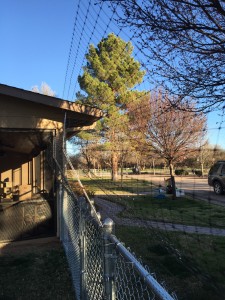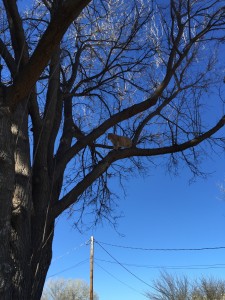Inside or Outside
 In my early years in animal rescue, I had a strong belief that cats should never be allowed outside. (This is one of the many agendas and beliefs that I had to examine as I really started listening to the animals.) I worked at a shelter in the center of a large city, and life outdoors was exceptionally risky for a cat. I really believed that all cats could adjust to living inside if they had a person who loved them enough and was committed to giving them the exercise and attention that they needed.
In my early years in animal rescue, I had a strong belief that cats should never be allowed outside. (This is one of the many agendas and beliefs that I had to examine as I really started listening to the animals.) I worked at a shelter in the center of a large city, and life outdoors was exceptionally risky for a cat. I really believed that all cats could adjust to living inside if they had a person who loved them enough and was committed to giving them the exercise and attention that they needed.
And then I started really listening to the cats. Some, including my own, said to me,
My life is not worth living if I can’t be outdoors and touch the earth.
“Really?” I said. “Not worth living? You mean you’d rather die?”
Yes.
And so, as with so many of my closely-held ideas, beliefs, and agendas, I had to do some serious soul-searching.
And I had to figure out how to allow my cats their outside time in a way that is safe for them and also honors my responsibility to them as their guardian and allows me to sleep at night.
This is also a very common discussion that I have with clients and cats in my animal communication practice. Over the years, I’ve learned that cats generally will fall into one of three “camps” with the indoor-outdoor question:
1. The “I Want to Be Inside” Camp: “Why would I want to go out there? It’s noisy and scary. Give me my feather pillow and my catnip toy, please, and fetch me my premium fish dinner.”
2. The “Take It or Leave It” Camp: “Outside is okay and I like to watch the birds and bugs, but mostly I want to be inside.” Our cats Maraya, Maddy, and Knox are in this group. They are content being in an enclosed, safe outdoor space with a bit of sunshine and fresh air, and then they are ready to come in and sit on our computers laps.
3. The “I’d Rather Die Than Be Confined Indoors Like a Prisoner” Camp: “My life is not worth living if I can’t be outside and touch the Earth.” Our cats Milo, Louie, and Farrah are in this group.
Louie, in particular, has shown me that one of his missions in this life is to do very deep spiritual work with the Earth, and so he spends much of his time outdoors in deep meditation. I’ve learned a tremendous amount from him about the magnetic and ley lines of the earth, the energetic meridians and grid, and I’ve learned to respect the time that he spends outdoors the way I would a monk who was in his cave praying.
Here’s a Story…
As my partner and I prepared to relinquish our hard-earned independence embrace the joys of sharing a household, we also worked hard to prepare to blend our animal families….think “The Brady Bunch,” with a whole lot more litter boxes, dog hair, and no Alice.
(We’re still working on the song. See the Meet the Staff page for photos of the new expanded family!)
Our new home is perfect for animals…it has lots of room indoors and out for each to have privacy, and enough separate spaces to contain our “problem” friends (we’re looking at you, Milo…).
Still, we are in a rural area in the high desert, in a neighborhood where coyotes, raptors, and other predators are common. I love hearing the coyotes singing at night and in the early morning, but I don’t want to hear them singing about their delicious cat breakfast. Really.
So, we’ve been working on creating a really wonderful and safe home for all of our cats, indoors and out, that allows our “Must Be Outdoors” friends to have what they require for happy lives, while doing our best to keep them safe.
Knowing that we are not the only Crazy Cat People in the world (thankfully!), I thought that sharing some of our creations and techniques here on the blog would be interesting and helpful for others.
Cat Fencing
This is the cornerstone of our system. We’ve enclosed approximately 1/4 of our yard with cat fencing, which I also used at my previous home. The perimeter of our yard is also completely fenced, and so the cat-fenced area of the yard is a “fence within a fence.”
Cat fencing attaches to an existing fence (ours is chain link) or can be purchased as a stand-alone fence.
 Here are some options and sources for cat fencing:
Here are some options and sources for cat fencing:
1. Affordable Cat Fence: This is the system that we use and that I also used at my previous home. This system was created by serious, dedicated cat lovers, and they perfected the system to keep their own large family of rescued cats safe.
The simple fence is based on the principle that cats won’t climb something that is unstable (the netting), and also they won’t go backwards and upside down (thus the angle of the stanchions that hold the netting in place.)
The fencing also prevents stray and feral cats from coming into the yard, as they can’t climb on the netting on the top of the fence.
The system includes the pre-made metal stanchions, mesh netting, zip ties, and hose clamps to attach the stanchions to the fence posts and gates. There is also an option for trees (see below).
Here’s what I love about this system:
- It is reasonably priced compared to others.
- The customer service is fantastic–you can talk to a real live person who also happens to be one of the owners of the company and who really knows both the system and cats. And, get this, her name is Alice…
- The system is simple to install. It’s time-consuming and a bit tedious, but it’s very doable even for people with limited skill with tools. That’s me. 🙂 The only tools required are an electric screwdriver/drill and hands. And a bit of patience.
2. Purrfect Fence Company: This is another reputable, high-quality fence that has a lot of good feedback and support from the cat community. It’s a bit pricier than the one we used, but it includes a stand-alone option for people who don’t have a preexisting fence and can’t or don’t want to add one.
3. Alley Cat Allies (a fantastic organization that advocates for stray and feral cats), also has instructions for a DIY cat fence using netting, garden poles, fishing line, and wire: Alley Cat Allies Do-It-Yourself Fence for Domestic Cats.
[Please note that all of these fences are designed for domestic cats, not ferals. Feral cats require a whole different level of care and freedom. You can read my post The Joys of Feral Cats for more info on working with feral cats compassionately and humanely.]
Cat fencing does not necessarily protect against aerial predators (raptors), and so we’ve also made sure to have a lot of safe hiding places in the yard (bushes, dog houses, and smaller structures) where the cats can hide out and be safe. We also don’t allow anyone to be in the cat yard after dark.
Tree Barrier
As soon as the cat yard was done, we let Milo out to test it. And in about 2.5 seconds, he had climbed the mulberry tree…and would quickly have figured out how to catapult himself into the adjacent pine tree and out of the safety of the cat yard. Here he is, very pleased with himself in his high perch:
And so, we created our own tree barrier using branches, leftover stanchions, and netting:
It works…the cats can climb to the first Y in the tree, but no farther. Both of the cat fence companies also sell tree kits.
Predator Lights
This is the final little piece of our system: The Night Guard Solar Predator Control Lights. These solar-powered lights attach to the fence and blink a red light that is supposed to deter predators if placed at their eye level. We’ve got them around the perimeter of the cat fence, as well as outside our chicken run. They are relatively inexpensive, and look like a security system…which they are…for the animals. I can’t say for sure whether or not they work…I used them at my previous home, as well, and had no issues with predators. They have received a lot of good reviews and I figured that they are worth using as a bit of extra insurance.
The Catio
We were blessed to find a house that had a lovely patio with a roof, tile floor, and two doors into the house. We decided to screen it in using a heavy-gauge cat-claw-resistant screen, and we subsequently created a “catio.” This is a great space for our “tweeners”…our cats who are in the “like a bit of the outdoors but like the comforts of inside” group.
We have furnished the catio with cat-friendly furniture for both our cats and ourselves. The cats really enjoy looking out at the insects and birds, watching the clouds and the leaves, and having easy access to indoors when they want it.
The catio also opens into the cat yard, so those who wish can have their “truly outdoors” time in a safe way, and we can also close the doors at night.
We’re still adding components and tweaking the cat yard and catio — moving things around, adding more bushes, and watching the cats and asking them what they need and want to feel secure and safe during their outdoor time.
Louie often advises students in my animal communication classes to
Get outside, put your paws on the earth, and lie with your belly in the sun.
We’re happy that our cats can do this in a way that’s safe for them, and it has been fun for us to create this space.
Disclosure: some of the links in this post are affiliate links. If you click on the link and decide to make a purchase, I may receive a commission. I only link to products and services that I have personally experienced and trust.







